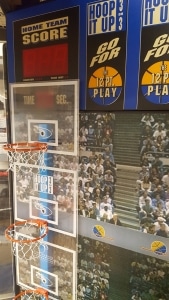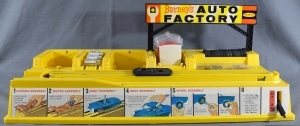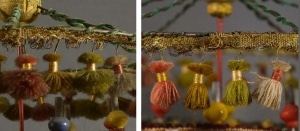 I grew up in a family of makers before the Maker Faire existed. My grandmothers could knit, sew, make jewelry, or hand hook a rug. They were the early generation of makers who would “use it up, wear it out, make it do” in order to make things last. My parents knew about organic gardening, fine tailoring, hand painting folk art whirligigs, and repairing furniture. Our house was filled with craft projects and lots of creativity. Parties with friends involved papermaking, bookbinding, pottery, tie-dye, and batik. Quiet weekends were spent watching other people make things on PBS’s The New Yankee Workshop. During outings or shopping trips, my parents would say, “We could make that!” I grew up making things, in a family that collects antiques, with a subscription to Smithsonian magazine. Based on that background, it seems like I’ve been training my entire life to be a conservator. Conservation requires science, art, creative thinking, manual skills, and a certain type of personality that enjoys repetitive tasks. Recently, I created replacements for miniature basketball nets in the museum’s Hoop It Up arcade gam e using macramé. I saw the deteriorated originals and said to myself, “I could make that.” And, sure enough, I did. Undoubtedly my crafty grandmothers would be proud.
I grew up in a family of makers before the Maker Faire existed. My grandmothers could knit, sew, make jewelry, or hand hook a rug. They were the early generation of makers who would “use it up, wear it out, make it do” in order to make things last. My parents knew about organic gardening, fine tailoring, hand painting folk art whirligigs, and repairing furniture. Our house was filled with craft projects and lots of creativity. Parties with friends involved papermaking, bookbinding, pottery, tie-dye, and batik. Quiet weekends were spent watching other people make things on PBS’s The New Yankee Workshop. During outings or shopping trips, my parents would say, “We could make that!” I grew up making things, in a family that collects antiques, with a subscription to Smithsonian magazine. Based on that background, it seems like I’ve been training my entire life to be a conservator. Conservation requires science, art, creative thinking, manual skills, and a certain type of personality that enjoys repetitive tasks. Recently, I created replacements for miniature basketball nets in the museum’s Hoop It Up arcade gam e using macramé. I saw the deteriorated originals and said to myself, “I could make that.” And, sure enough, I did. Undoubtedly my crafty grandmothers would be proud.
 But I’m not alone in my interest in and affection for creative pursuits. Playing by making always promises the result of having a new thing. Remco offered an exciting way to build your own toy cars with Barney’s Auto Factory Motorized Assembly Line. A car chassis rolls down the assembly line as kids add parts and customize a toy car. Safety features were not much of a concern in the early years of maker toys and building sets. The 1950 Gilbert Atomic Energy Set came with radioactive materials and a comic book in which the cartoon character Dagwood shows how to split an atom. In the 1960s, kids could play with Mattel’s Creepy Crawlers by making plastic bugs with a hot toaster oven and die-cast molds. Advertisements for Creepy Crawlers told kids that “all you need to make a bug is a Thing Maker set and an electric plug.” Kids could also transform sheets of plastic into toys and badges with Mattel’s Vac-u-Form Thing Maker set. Perhaps after years of playing with Thing Maker a few kids grew up to be industrial designers.
But I’m not alone in my interest in and affection for creative pursuits. Playing by making always promises the result of having a new thing. Remco offered an exciting way to build your own toy cars with Barney’s Auto Factory Motorized Assembly Line. A car chassis rolls down the assembly line as kids add parts and customize a toy car. Safety features were not much of a concern in the early years of maker toys and building sets. The 1950 Gilbert Atomic Energy Set came with radioactive materials and a comic book in which the cartoon character Dagwood shows how to split an atom. In the 1960s, kids could play with Mattel’s Creepy Crawlers by making plastic bugs with a hot toaster oven and die-cast molds. Advertisements for Creepy Crawlers told kids that “all you need to make a bug is a Thing Maker set and an electric plug.” Kids could also transform sheets of plastic into toys and badges with Mattel’s Vac-u-Form Thing Maker set. Perhaps after years of playing with Thing Maker a few kids grew up to be industrial designers.
 The urge to create toys persists but, over the years, Thing Maker sets have changed. Mattel’s latest Thing Maker is a 3-D printer that allows kids to design, customize, and print 3-D plastic toys. In the contemporary Thing Maker, little fingers can’t get into the heated parts, thanks to a door that locks during printing. Today kids and parents who make things can find plans for how to make a Fidget Spinner—this year’s latest toy craze—and it’s possible to learn to make or do almost anything through YouTube videos, Make magazine, GitHub, and Thingiverse.
The urge to create toys persists but, over the years, Thing Maker sets have changed. Mattel’s latest Thing Maker is a 3-D printer that allows kids to design, customize, and print 3-D plastic toys. In the contemporary Thing Maker, little fingers can’t get into the heated parts, thanks to a door that locks during printing. Today kids and parents who make things can find plans for how to make a Fidget Spinner—this year’s latest toy craze—and it’s possible to learn to make or do almost anything through YouTube videos, Make magazine, GitHub, and Thingiverse.
In my professional life, I appreciate that conservators have utilized the Internet to share open workflows for digitizing audio-visual media, to communicate complex treatment methods, and to share historic factory footage to remind us how plastic things were once made. Knowing how things are made helps conservators understand why things fail, deteriorate, or age. Being able to make things prepares conservators for the challenges of re-making things that are broken. With years of spinning, weaving, knitting, and playing with fiber, I recently found myself well equipped to clean the wool tassels on a toy carousel and restore them to their original intended shape. Every new material challenge draws on my past experience, whether as a playful maker or at the conservation bench through creative experimentation.



